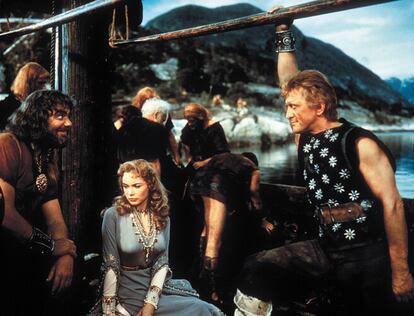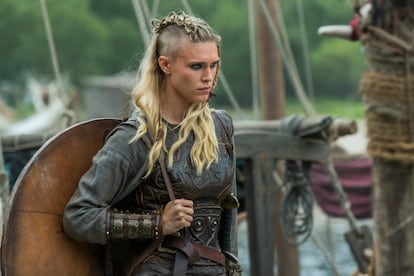
Accustomed to swords, sagas and long shipsthe regular reader of Viking history might be surprised to find their feces. Even if they are truly epic, worthy of Thor, like those left by a Viking in Jórvik, present-day York, in the 9th century and which constitute, with their 20 x 5 centimeters and 227 grams, the largest individual human deposit ever discovered. We don’t know the name of the brave Viking, but the discovery of the coprolite (fossilized excrement) has allowed us to know many things about his life and above all about his diet and the state of his intestinal transit: terrible. The London historian Eleanor Barraclough dedicates space to the coprolite majestically called Lloyds-Bank – because it was found during the excavation of a site for the construction of the bank’s branch in York in 1972 – in her very interesting book. Viking gold (Book in the attic, 2025), in which he uncovers hidden stories of the Viking Age and tries to bring the reader closer to the lives of ordinary people of that time.
The original title of the work is Embers of the hands(embers of the hands) (A Kenning, metaphor or Viking poetic riddle, for gold), referring to the idea that many Viking objects, even very humble ones (a staff with runes to help during childbirth, a wooden high chair for a child, the tender drawings of another named Onfim on a birch bark, the mark of a teenager’s bare foot on the Gokstad ship, a glove, a skate), still contain the vital fire of their creation and by blowing metaphorically on them we can make them relive. The gold in the Spanish title also serves as a warning that the most valuable in archeology and history is often not the brightest (like the Viking of Jórvik).
Barraclough, a young woman with moss-green eyes who won’t give her age (she reasons that providing personal information leaves her vulnerable to harassment from far-right Vikings fans who hate her debunking approach), laughs mischievously in a Barcelona hotel bar. “No, I didn’t put that Viking poop there to provoke; in fact on the cover of the book already appears, among other objects, a bronze statuette of what appears to be the fertility god Frey with an erect and pointed penis.” Stool, he continues, is actually an ordinary part of life and it makes perfect sense to talk about it. Typically, he points out, historical human excrement appears archaeologically as a common mass at the bottom of an old latrine. Finding a solitary place, he points out, opens an exciting window into learning about a specific individual from the past.
This Viking “was not a particularly healthy human being, his feces consisted mainly of meat, bread and hundreds of parasite eggs, which shows that he suffered from a troublesome intestinal worm infection.” Barraclough notes that the individual had not defecated for several days. As he does so, it is unknown if he has the sword in his hand and shouts “I hate it!” The process “should not have been at all comfortable and the relief, in the end, remarkable.” In 1991 paleoeschatologist (now specialist) Andrew Jones assured with an involuntary accent montyphytonian: “This is the most interesting excrement I have ever seen; in its own way, it is more precious than the crown jewels.”

Eleonor Barraclough takes this opportunity to point out that the story of the coprolite has continued and in 2003 it made headlines again when it fell from the hands of a teacher during a school visit to the Jorvik Viking Center where it is on display (the only exhibition that can safely be said to be crap) and broke into three pieces. The expert reflects with a very British sense of humor that “not even a fossilized deposition, hardened by the passage of more than a millennium, escapes the destiny that the Norns (Nordic deities weavers of destiny) have woven for it.” And we remember that Odin himself was cornered when fleeing from the giants after having stolen from them, drinking it, the mead of the poem “and let a stream escape from behind as he fled”. It was said that those who drank the mead that flowed from Odin’s mouth composed beautiful verses, while those who drank the mead that came out the other side came out with mediocre or risqué verses.
Viking golda story of ordinary human beings told “through the small fragments that have survived the vagaries of chance and time”, it contains many unexpected stories of the people of the North, the normal ones, Barraclough underlines, those left in the shadow of great figures such as Harald Hardrada, Erik the Red, Leif Eriksson, Olaf Tryggvason or Sven Barba Partida. The historian cites characters such as a walrus hunter in Greenland – whose arduous settlement, in her opinion, was not very different from the attempt to colonize the moon –, an imperial bodyguard of the Varangian (Viking) guard in Constantinople, a nomadic reindeer herder who crossed the Arctic tundra, a British slave who worked the poor volcanic soil of Iceland or the many anonymous women who spent their lives weaving sailors’ clothes and sails gods long ships. “Without domestic textile production there would have been no Viking Age or expansion into the North Atlantic islands,” says the specialist. And he points out: “If we remove the fabrics and the women, all that remains of the Vikings are a few naked men in a rowing boat, and if we remove from the equation the children that the women gave birth to and cared for, in a short time you will only have the boat.”

Barraclough, who previously published in Penthouse Beyond the lands of the north (2023), a splendid investigation into Viking journeys based on the sagas and during which she herself traveled to extreme places such as the ancient settlements of Greenland, recalls that to complete the 112 square meter sail of a Drakkar, a person would need 9 years. “This allows us to understand how hard women worked, which is also attested by the conservation of Nordic textiles: recycled and repaired garments (usually from Fantastic, raw wool fabric), sewn, mended, mended again and reused”.
Contrary to the cliché, the Vikings, the historian points out, were clean compared to what was popular then. They also changed their socks and regularly used a comb (many have been found). In fact, the name of the Sabbath in Old Norse was laugardagr (bathing day), and names like that of the queen of the Ragnar Lodbrok saga (and the series Vikings), Áslaug (“Divine Bath”) are linked to this activity. The Valkyries sported gorgeous hair. Abbot Aelfric even warned the Anglo-Saxons of the danger of emulating the hairstyle, hairstyle (short and shaved at the back, long at the front) and fashion of the Norwegians, “the scandi-chic” observes Barraclough.

Regarding two current issues regarding the Vikings, the existence of female warriors and identity queerBarraclough, who quotes Neil Price in his acknowledgments, sees them as two aspects of the same thing. “We must try not to be anachronistic, it is clear that we find cases of fluid identity in the Viking world, such as the god Loki himself, transformed into a mare who gives birth to the colt Sleipnir, Thor disguised as a bride or Odin himself, of whom I show in the book a figurine in which he appears dressed as a woman. But beyond the divine sphere we are not so sure. There could be female warriors, we must be careful in drawing hasty conclusions, the escudera is a figure that existed, but perhaps did not fight What we know is that there were expressions for sexuality, identity and non-normative practices, such as. argr, perverted, or deafnnpenetrated. And terms that indicate that not everyone played prescribed gender roles, such as fannflugawoman running away from penis, or fudflogiman running away from vagina”.
As for whether films and series help or, on the contrary, spread the truth about the Vikings, he reflects: “Even if some productions are disappointing from a historical point of view, many contribute to raising awareness of the Vikings and, by doing so with a dramatic sense, arouse great interest in them. You have to be open-minded. I liked it a lot. The man from the north, by Robert Eggers, and the sequence in which he cuts off the head of a zombie warrior and places it between the buttocks of the dead man to prevent him from resurrecting: this actually happened in sagas, such as that of Grettir, from the 14th century.





